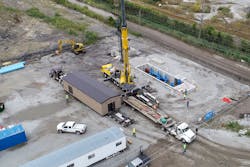The village of Homewood, Illinois, like many other Chicagoland municipalities, has long relied on Lake Michigan for its water. While Homewood was not looking to change the water source itself, the village needed to find a way to better serve the communities’ water needs while staying cost-effective.
Historically, Homewood’s Lake Michigan water came from Harvey, Illinois, about three miles to the north. When deciding to shift over to Chicago Heights, the water would need to travel a bit further, requiring new infrastructure. Homewood hired the team at Burns & McDonnell to manage the project, which brought in Metropolitan Industries to assist with design and to manufacture the resulting system.
A Record-Breaking Pump Station
Homewood needed a brand-new structure to house the necessary equipment. By combining our pumping and mechanical equipment knowledge with our in-house fabrication capabilities, Metropolitan Industries built the largest pump station we’ve ever created.
Measuring 16-feet wide, 13-feet tall, and a mammoth 52-feet long, the Homewood pump station is the result of months of design work and collaboration with Burns & McDonnell, followed by a year of careful construction. Of course, that timeline includes more than the building itself. Along with constructing the two-room, fully custom, climate-controlled pump station entirely inside our Romeoville, Illinois headquarters — our teams were busy ensuring every aspect of the facility would meet Homewood’s needs for years to come. Most of that effort went toward three separate areas:
1. The Pipe Gallery
Fabricated and powder coated by our in-house team of welders, which can customize just about any component in any size.
2. Custom Fittings for Unconventional Pumps
The upper-level pumphouse utilizes three horizontal split case pumps at 45-degree angles to fit in the 16-foot width of the space - allowing for easy serviceability. The lower-level piping gallery houses the 24-inch piping and valves of the water main connections, while the pumps’ suction and discharge valves and piping connected the three pumps to the mains below. By producing our own fittings, we were able to reduce overall dimensions and exercise some creativity without requiring additional space.
3. State-of-the-art SCADA
Incorporated with MetroCloud, our dedicated cloud SCADA system, to provide Homewood with intuitive pump control capabilities and unmatched visibility into their system. Thanks to the addition of a diesel generator, also supplied by Metropolitan, the entire system can remain online even if the utility power fails.
Orchestrating a Seamless Switch without a Hitch
The result of these efforts is a housed booster pump system that’s so large it required all hands-on deck when moving out of our facility. A 100-foot trailer with hydraulics was used during transport while careful route planning allowed for seamless arrival to its new home near the Thornton Quarry.
With the help of onsite installing contractors, the eight pipe connections on the building joined as planned with the piping in the field (also built by Metropolitan), allowing for a true plug-and-play experience. The culmination of a year’s worth of work was connected and ready for use, allowing for an expedited path towards startup.
Today, a 24-inch suction header, a 24-inch discharge header, a 24-inch flow meter, and 16-inch branch pipes lead to each of the pumps. When combined with ultra-low harmonic variable speed drives, an automated caustic dosing system, and round-the-clock system connectivity, this new system provides an updated and reliable water supply to the Village of Homewood and helps the municipality feel confident in their decision to switch water suppliers.

